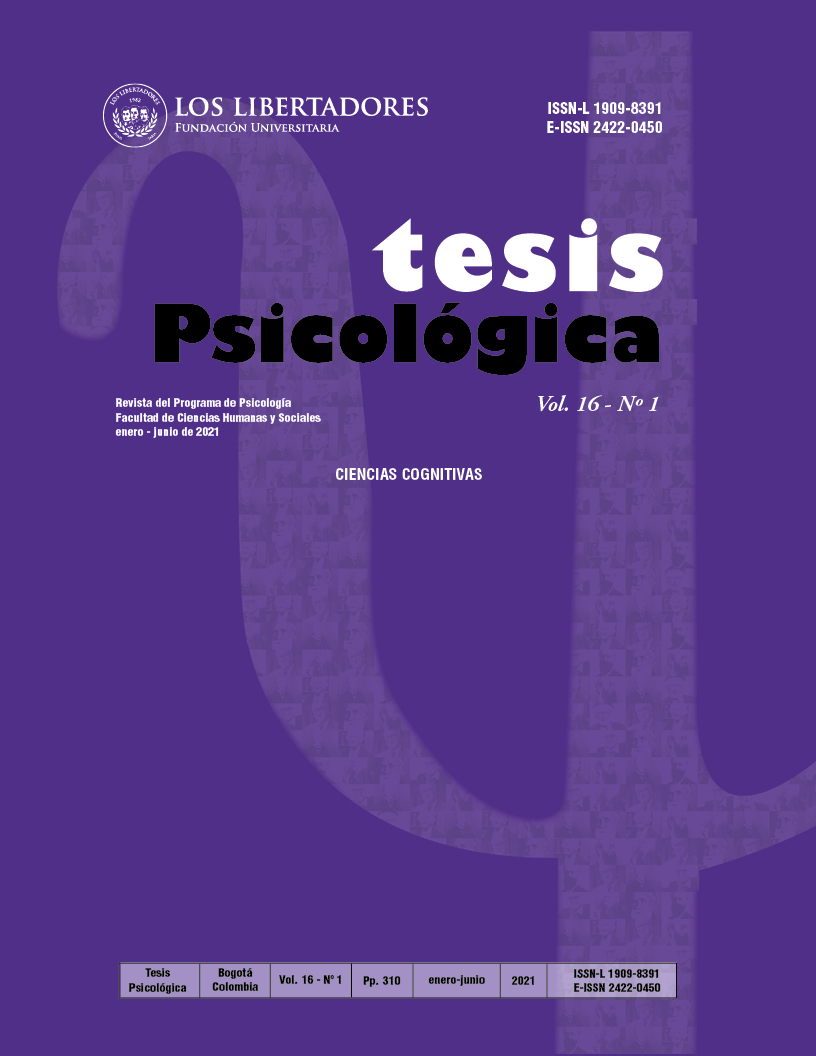Development of the theory of the mind in children with Attention Deficit Hyperactivity Disorder
DOI:
https://doi.org/10.37511/tesis.v16n1a3Abstract
Objective: to determine and describe the development of Theory of Mind (ToM) in children diagnosed with Attention deficit hyperactivity disorder (ADHD) with ages between 6 and 12 years. Methodology: it was an empirical-analytical study with descriptive exploratory emphasis and control group. A group of children diagnosed with ADHD was selected, all of them assigned to the Attentional Clinic Program of the Children's Hospital -Hospital Infantil-. The controls were chosen in educational institutions. Population: 74 boys and girls between cases and controls participated in the study, 31.1% were of the combined type and 18.9% of the inattentive subtype. Instruments: A set of ToM tests was applied: facial expressions test, first and second-order false belief, Happé’s Strange Stories, Gaze Reading Test, and Paw Off Test. To Evaluate executive functions the Stroop test was applied, WISC III Digit Retention Test, and the ENI Card Classification Test -Infant Neuropsychological Evaluation-. Variables: To be part of this research, children had to be in school, diagnosed with ADHD and age was controlled. Results: It was found that there is a direct relationship between difficulties in the development of ToM and ADHD. Children with ADHD obtained lower results in applied tests than the controls, although the differences were not statistically significant. Conclusions: It is concluded that children with ADHD have a greater risk of presenting difficulties in the development of ToM.
Downloads
References
Abad-Mas, L., Ruiz-Andrés, R., Moreno-Madrid, F., Sirera-Conca, A., Cornesse, M., Delgado-Mejía, I., & Etchepareborda, M. (2011). Entrenamiento de funciones ejecutivas en el trastorno por déficit de tención/hiperactividad. Rev Neurol, 52 (1), S77-S83. https://doi.org/ 10.33588/rn.52S01.2011012.
Arango, O., Montoya, P., Puerta, I., & Sánchez, J. (2014). Teoría de la mente y empatía como predictores de conductas disociales en la adolescencia. Escritos de Psicología, 7(1), 20-30. http://dx.doi.org/10.5231/psy.writ.2013.2810
Asiáin Rubio, P., Tirapú-Ustarroz, J., López Goñi, J. J., & Melero Pérez, R. (2013). Teoría de la mente en los subtipos del trastorno por déficit de atención e hiperactividad. ISEP Science, 4, 11-22. https://academica-e.unavarra.es/xmlui/handle/2454/35349.
Balmaceda, T. (2016). Tres décadas del test de la falsa creencia. Revista Argentina de Ciencias del Comportamiento 8 (2), 5-23. https://www.redalyc.org/articulo.oa?id=3334/333449322002
Barkley, R. A., Grodzinsky, G., & DuPaul, G. J. (1992). Frontal lobel functions in attention deficit disorder with and without hyperactivity. A review and research report. Journal of Abnormal Child Psychology, 20(2), 163-88. https://doi.org/10.1007/BF00916547
Baron-Cohen S., Leslie, & Frith, U. (1985). Does the autistic child have a ‘theory of mind’? Cognition, 21, 37-46. https://doi.org/10.1016 / 0010-0277 (85) 90022-8.
Baron-Cohen, S., O´Riordan, M., Stone, V., Jones, R., & Plaisted, K. (1999). Test Metidas De Pata. Un nuevo test de sensibilidad social: detección de metidas de pata en niños normales y niños con Síndrome de Asperger. Downing St. Cambridge: Departamento de Psicología y Psiquiatría Experimental. Universidad de Cambridge. Traducción: N. Grañana, C.Serrano, R. Allegri, Argentina: Laboratorio de Memoria. Hospital Zubizarreta.
Baron-Cohen, S., Wheelwright, S., Hill, J., Raste, Y., & Plumb, I. (2001). The “Reading the Mind in the eyes” Test Revised Version: A Study with Normal Adults, and Adults with Asperger Syndrome or Hight-functioning Autism. J. Child Psychology, Psychiatric, 42 (2), 241-251. https://pubmed.ncbi.nlm.nih.gov/11280420/
Baron-Cohen, S., & Wheelwright, S. (2004). The Empathy Quotient: An Investigation of Adults with Asperger Syndrome or High Functioning Autism, and Normal Sex Differences. Journal of Autism and Developmental Disorders, 34 (2). https://link.springer.com/article/10.1023/B:JADD.0000022607.19833.00
Betancur-Caro, M. L., Molina, D. A., & Cañizales-Romaña, L. Y. (2016). Entrenamiento Cognitivo de las Funciones Ejecutivas en la Edad Escolar. Revista Latinoamericana de Ciencias Sociales, Niñez y Juventud, 14 (1), 359-368. http://revistalatinoamericanaumanizales.cinde.org.co https://doi.org/10.11600/1692715x.14124160615
Buhler, E., Bachman, C., Goyert, H., M-Heinzen, M., & Camp, I. (2011). Differential diagnosis of autism spectrum disorder and attention deficit hyperactivity disorder by means of inhibitory control and 'theory of mind', 41 (12), 1718-26. https://doi.org/10.1007 / s10803-011-1205-1
Butman, J., & Allegri, R. F. (2001). A Cognição Social e o Córtex Cerebral. Psicologia: Reflexão e Crítica, 14 (2), 275-279. http://dx.doi.org/10.1590/S0102-79722001000200003.
Ceardi, A., Améstica, J., Núñez, C., López, V., López, V., & Gajardo, J., (2016). El cuerpo del niño como trastorno: aproximaciones discursivas al abordaje del TDAH. Athenea Digital, 16 (1), 211-235. http://dx.doi.org/10.5565/rev/athenea.1478
Damasio, A. (1994). El Error de Descartes. Santiago, Chile: Editorial Andrés Bello.
Davidson, R., & Irwin, W. (1999). The functional neuroanatomy of emotion and affective style. Trends in Cognitive Sciences, 3 (1). https://doi.org/10.1016 / s1364-6613 (98) 01265-0
De Achaval, D. (2010). Evaluación de la cognición social en pacientes con esquizofrenia y sus familias de primer grado no afectados. Universidad de Belgrano En: Las Tesinas de Belgrano. http://repositorio.edu.edu.ar:8080/xmlui/handle/123456789/538
Giraldo, Y., & Chaves, L. (2014). Trastorno por déficit de atención/hiperactividad (tdah) y dificultades en lenguaje pragmático. Revista de Psicología Universidad de Antioquia, 6 (1), 41-56. https://revistas.udea.edu.co/index.php/psicologia/article/view/21616
Golden, Ch. (2001). Stroop. Test de Colores y Palabras. Madrid: TEA Ediciones.
González, A., Barajas, E., Linero, M., & Quintana, I. (2004). Deficiencia Auditiva: experiencia comunicativa, lenguaje y Teoría de la Mente. Separata FIAPAS-99. https://dialnet.unirioja.es/servlet/articulo?codigo=1005492
Greenbaum, R. L., Stevens, S. A., Nash, K., Koren, G., & Rovet, J. (2009). Social cognitive and emotion processing abilities of children with fetal alcohol spectrum disorders: a comparison with attention deficit hyperactivity disorder. Children's Mental Health Team, 33 (10), 1656-70. https://doi.org/10.1111 / j.1530-0277.2009.01003.x
Happé, F. (1994). An advanced test of theory of mind: understanding of story characters’ thoughts and feelings by able autistic, mentally handicapped, and normal children and adults. J Autism Dev Disord, 24, 129-5 https://doi.org/10.1007 / BF02172093
Herrera Pino, J. A., & Castellanos, C. E. (2010). Interpretación Neuropsicológica del Test Colores y Palabras de Stroop. Monografías de Evaluación Neuropsicológica. Buenos Aires: Universidad Maimónides.
Iglesias-Hoyos, S., Del Castillo, A., & Muñoz-Delgado, I., (2016). Reconocimiento facial de expresión emocional: diferencias por licenciaturas. Psichological Research Records, 2494-2499. www.sciencedirect.com. https://doi.org/10.1016/j.aipprr.2016.07.001
Latorre-Cosculluela, C., Liesa-Orús, M., & Vázquez-Toledo, S. (2018). Escuelas inclusivas: aprendizaje cooperativo y TAC con alumnado con TDHA. magis, Revista Internacional de Investigación en Educación, 10 (21), 137-152. https://doi.org/10.11144/Javeriana.m10-21.eatt
León Rodriguez, D., & Cardenas, F. (2016). Aproximación Neurodinámica a la Cognición Social. Universitas Psychologica, 15 (5). https://doi.org/10.11144/Javeriana.upsy15-5.ancs
López-Villalobos, J. A., Serrano-Pintado, I., Andrés-De Llano, J., Sánchez-Mateos, J., Alberola-López, S., & Sánchez-Azón, M. I. (2010). Utilidad del test de Stroop en el trastorno por déficit de atención/hiperactividad. Rev Neurol, 50 (6), 333-340. http://pediatrasandalucia.org/Docs/TDAH/1_05_TDAH.pdf
Matute, E., Rosselli, M., Ardila, A., & Ostrosky, F. (2007). Evaluación Neuropsicológica Infantil. México: Manual Moderno.
Mejía, C., & Varela, V. (2015). Comorbilidad de los trastornos de lectura y escritura en niños diagnosticados con TDAH. Psicología desde el Caribe, 32 (1), 121-143. https://www.redalyc.org/pdf/213/21337152005.pdf
Miranda-Casas, A., Baixauli-Fortea, I., Colomer-Diago, C., & Roselló-Miranda, B. (2015). Autismo y trastorno por déficit de atención/hiperactividad: convergencias y divergencias en el funcionamiento ejecutivo y la teoría de la mente. Rev. Neurol 2013, 57 (Supl 1), S177-S184. https://dialnet.unirioja.es/servlet/articulo?codigo=4719613
Ostrosky, F., & Vélez. A. (2013). Neurobiología de las Emociones. Revista Neuropsicología, Neuropsiquiatría y Neurociencias, 13 (1), 1-13. http://feggylab.mex.tl/imagesnew/7/0/4/8/6/neurobiologia%20de%20las%20emociones.pdf
Orozco, N., & Zuluaga, J. (2015). Teoría de la Mente en niños y niñas con Trastorno por Déficit de Atención con Hiperactividad “TDAH”. Tesis Psicológica, 10(2), 134-148. https://www.redalyc.org/pdf/1390/139046451009.pdf
Pineda, W., Acosta, J., Cervantes, M., Giménez, G., Núñez, M., Sánchez, M., & Puentes, P. (2012). Análisis de la Teoría de la Mente en Niños con Trastorno por Déficit de Atención-Hiperactividad. VIII Congreso Internacional de Cerebro y Mente. Revista de Neuropsicología, Neuropsiquiatría y Neurociencias, 12, 163-188. http://www.fecoer.org/wp-content/uploads/2012/09/memorias_vii_congreso_cm_2012-ee29ebe31a6dac7ae17576469f3e7f5c.pdf
Pineda, W., & Puentes, P. (2013). Estudio expost facto de la Teoría de la Mente en niños escolarizados diagnosticados con trastorno por déficit de Arención-hiperactividad. Rev. Tesis Psicológica, 8 (2), 144-161. https://www.redalyc.org/pdf/1390/139029743010.pdf
Puentes-Rozo, P. J., Barceló-Martínez, E., & Pineda, D. A. (2008). Características conductuales y neuropsicológicas de niños de ambos sexos, de 6 a 11 años, con trastorno por déficit de atención/hiperactividad. Rev Neurol, 47(4), 175-184. https://doi.org/10.33588/rn.4704.2008201
Puig Jover, B. (2017). Acompañamiento Emocional a padres de hijos con Tdah. Projecte Final del Postgrau en Educació Emocional i Benestar. Barcelona: Universitat de Barcelona. http://hdl.handle.net/2445/118535
Ramos-Galarza, C., Bolaños, M., Paredes, L., & Ramos, D. (2016). Tratamiento Neuropsicológico del TDAH en Preescolares: Entrenamiento de la Función Ejecutiva. Rev. Ecuat. Neurol. 25 (1-3). http://revecuatneurol.com/magazine_issue_article/tratamiento-neuropsicologico-tdah-preescolares-entrenamiento-funcion-ejecutiva/
Ríos-Flórez, J., & Flórez-Barco, E. (2017). Teoría de la mente en niños de 6 a 10 años de edad con antecedente de nacimiento prematuro y en edad escolar. Psychologia, 11 (2), 29-43. https://doi.org/10.21500/19002386.2626
Rodillo, E. (2015). Trastorno por Déficit de Atención e Hiperactividad (TDAH) en Adolescentes. Rev. Med. Clin. Condes -2015, 26 (1), 52-59. https://doi.org/10.1016/j.rmclc.2015.02.005
Román, F., Rojas, G., Román, N., Iturry, M. Blanco, R., Leis, A., Bartoloni, L., Allegri, R., & Argencog. (2012). Baremos del Test de la Mirada en español en adultos normales de Buenos Aires. Revista Latinoamericana de Neuropsicología, 4(3), 1-5. https://doi.org/10.5579/ml.2012.0108
Roqueta, C. (2009). Pragmática y Cognición Social en niños y niñas con Trastorno Específico del Lenguaje (TEL). (Tesis doctoral). Universitat Jaume I de Castelló. Departamento de Psicologia Evolutiva, Educativa, Social y Metodología. https://www.tdx.cat/bitstream/handle/10803/384624/Tesis_Andres+Roqueta_C
Roqueta, C., Clemente, A., & Flores, R. (2012). Cognición social y competencia pragmática. El caso de niños y niñas con Trastorno específico del lenguaje. International Jornal of Psichological Research 5(1), 59-69. https://www.researchgate.net/publication/277261738_Cognicion_Social_y_competencia_pragmatica_El_caso_de_los_ninos_y_ninas_con_Trastorno_Especifico_del_Lenguaje
Rubiales, J., Bakker, L., Russo, D., & González, R. (2016). Desempeño en funciones ejecutivas y síntomas comórbidos asociados en niños con Trastorno por déficit de atención con hiperactividad (TDAH). Rev. CES Psicología, 9(2), 99-113. http://www.redalyc.org/articulo.oa?id=423548400007.pdf
Sánchez-Pérez, N., & González-Salinas, C. (2013). Ajuste Escolar del Alumnado con TDAH: Factores de Riesgo Cognitivos, Emocionales y Temperamentales. Electronic Journal of Research in Educational Psychology, 11(2), 527-550.
https://doi.org/10.14204/ejrep.30.1218
Serrano-Ortiz, J. (2013). Desarrollo de la Teoría de la Mente, lenguaje y funciones ejecutivas en niños de 4 a 12 años. (Tesis Doctoral). Universitat de Girona. http://hdl.handle.net/10803/123549
Tirapu-Ustárroz, J., Pérez-Sayes, G., Erekatxo-Bilbao, M., & Pelegrín-Valero, C. (2007). ¿Qué es la Teoría de la Mente? Rev Neurol, 44, 479-89. https://doi.org/10.33588/rn.4408.2006295
Trujillo, N., & Pineda, D. (2008) Función Ejecutiva en la Investigación de los Trastornos del Comportamiento del Niño y del Adolescente. Revista Neuropsicología, Neuropsiquiatría y Neurociencias, 8(1), 77-94. https://dialnet.unirioja.es/servlet/articulo?codigo=3987502
Uribe, L. H., & Miranda, A. (2000). Funciones Ejecutivas, Teoría de la Mente y Competencia Social en Niños con TDAH. (Tesis doctoral). España: Universidad de Valencia.
Urrego, Y., Restrepo, J., Pinzon, S., Acosta, J., Diaz, M., & Bonilla, C. (2014). Vínculos Afectivos en pares y cognición social en la infancia intermedia. Int. Psychological Research, 7(2), 51-63. http://www.scielo.org.co/pdf/ijpr/v7n2/v7n2a06.pdf
Wimmer, H., & Perner, J., (1983). Beliefs about beliefs: representation and constraining function of wrong beliefs in young children´s understanding of deception. Cognition, 13, 103-128.
https://doi.org/10.1016/0010-0277(83)90004-5
Zabala, M., Richards, M., Breccia, F., & López, M. (2018). Relaciones entre empatía y teoría de la mente en niños y adolescentes. Rev. Pensamiento Psicológico, 16 (2). https://doi.org/10.11144/Javerianacali.PPSI16-2.retm
Zegarra-Valdivia, J., & Chino-Vilca, B. (2017). Mentalización y Teoría de la Mente. Rev. Neuropsiquiatría 80 (3). Artículo Especial, Arequipa (Perú). http://dx.doi.org/10.20453/rnp.v80i3.3156
Zilver, A. (2017). Teorías acerca de la Teoría de la Mente. El rol de los procesos cognitivos y emocionales. Revista Neuropsicología Latinoamericana, 9 (3), 1-12. https://doi.org/10.5579/rnl.2017.0397
Downloads
Published
Issue
Section
License

This work is licensed under a Licencia Creative Commons Atribución-NoComercial-













